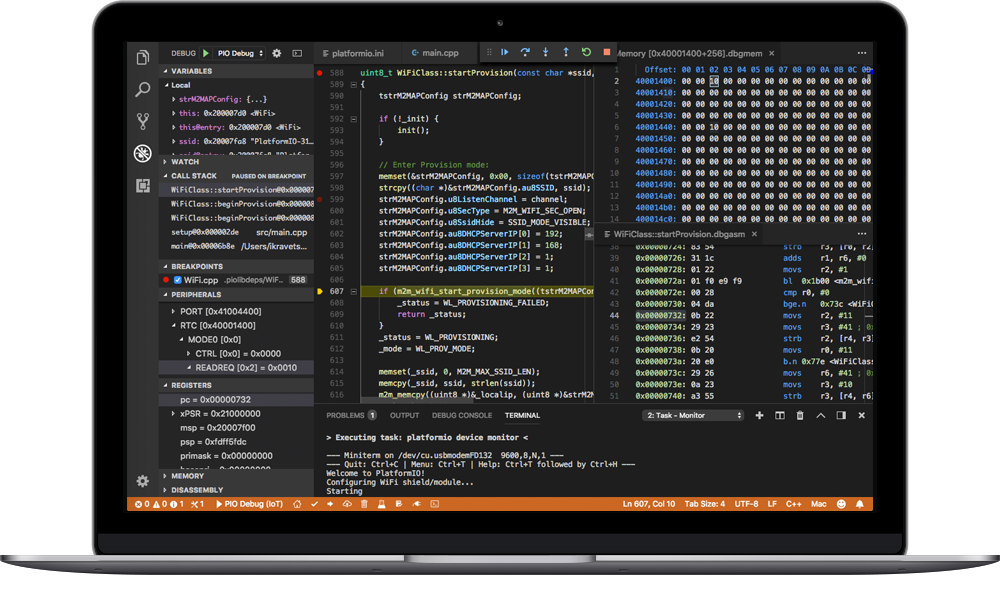Firmware Design Process Introduction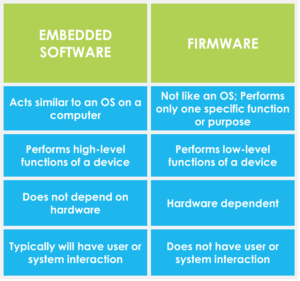
- Definition and Purpose of Firmware:
- Firmware refers to the software that is permanently stored in read-only memory (ROM) or flash memory of an embedded system.
- It serves as the intermediary between the hardware components and the higher-level software applications.
- Unlike traditional software, firmware is designed to be non-volatile, meaning it retains its instructions and data even when the power is turned off.
- Role of Firmware in Embedded Systems:
- Firmware plays a critical role in controlling the behavior of embedded systems, which are specialized computer systems designed to perform specific tasks.
- It interacts with the hardware components such as microcontrollers, sensors, actuators, and communication interfaces to enable the desired functionality of the embedded system.
- Firmware manages the system’s resources, handles input and output operations, and implements the required algorithms and protocols.
- Characteristics of Firmware Design:
- Size and Memory Constraints: Firmware typically operates within limited memory and storage space, necessitating efficient code optimization and data management techniques.
- Real-Time Responsiveness: Embedded systems often require real-time responses to external events, making firmware design crucial for meeting timing constraints and ensuring timely execution.
- Low Power Consumption: Firmware design should focus on minimizing power consumption to extend the battery life of portable devices or reduce energy usage in resource-constrained environments.
- Reliability and Stability: Firmware needs to be robust and stable, as embedded systems are often deployed in mission-critical or harsh environments where failures can have serious consequences.
- Constraints of Firmware Design:
- Hardware Limitations: Firmware designers must consider the capabilities and limitations of the underlying hardware, such as the processor architecture, memory types, and input/output interfaces.
- Time and Resource Constraints: Firmware development often faces tight schedules, requiring efficient use of development resources and balancing feature implementation with time-to-market considerations.
- Security Considerations: Firmware design should incorporate security measures to protect against unauthorized access, data breaches, and potential attacks on the system.
- Upgradability and Maintenance: Firmware should be designed with the ability to be updated or patched to address bugs, add new features, or address security vulnerabilities.
Understanding these fundamental facts about firmware design is crucial for successfully developing robust and efficient firmware for embedded systems. By considering the specific requirements, constraints, and purpose of firmware, designers can create software that effectively bridges the gap between hardware and higher-level software applications, ensuring reliable and optimized operation of embedded systems.
Firmware Development Process
- Requirements Gathering and Analysis:
- The firmware development process begins with gathering and analyzing the system requirements and specifications.
- This involves understanding the functionality, performance, and constraints of the embedded system to determine the firmware requirements.
- Effective requirements gathering ensures that the firmware design aligns with the overall system objectives and user needs.
- Firmware Architecture and Design:
- Firmware architecture defines the high-level structure and organization of the firmware, including the division of tasks and modules.
- Design decisions are made to determine the flow of data and control, interfaces with hardware components, and the overall system behavior.
- Modular and layered architectures are commonly employed to enhance code reusability, maintainability, and scalability.
- Implementation and Coding Practices:
- Once the firmware architecture and design are defined, the implementation phase involves translating the design into actual code.
- Coding practices such as following coding standards, using clear and meaningful variable and function names, and employing proper code documentation are essential for code maintainability.
- Good coding practices also include optimizing code for memory and performance, considering real-time constraints, and adhering to secure coding principles.
- Testing and Debugging Techniques:
- Firmware testing aims to identify and fix defects, validate functionality, and ensure the firmware meets the specified requirements.
- Techniques such as unit testing, integration testing, system-level testing, and acceptance testing are employed to verify different aspects of the firmware.
- Debugging tools and techniques, including software debuggers, hardware debugging interfaces, and logging mechanisms, assist in identifying and resolving issues in the firmware code.
- Version Control and Release Management:
- Version control systems, such as Git, are used to manage and track changes made to the firmware codebase over time.
- Version control facilitates collaboration among team members, provides a history of code changes, and enables easy rollbacks if necessary.
- Release management involves planning and coordinating the release of firmware versions, including creating release branches, documenting release notes, and ensuring proper configuration management.
Understanding and following an organized firmware development process is crucial for the successful development and maintenance of firmware in embedded systems. By emphasizing requirements gathering, thoughtful architecture design, efficient coding practices, rigorous testing, and effective version control, firmware designers can create robust and reliable firmware that meets the desired functionality, quality, and time-to-market goals.
Embedded Systems Programming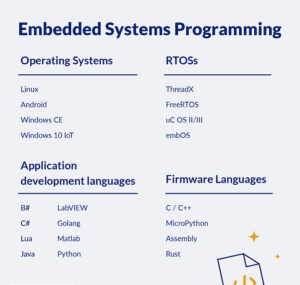
- Overview of Programming Languages for Firmware Development:
- Common programming languages for firmware development include C, C++, and Assembly.
- C is widely used due to its low-level control, efficiency, and close proximity to hardware.
- C++ provides additional features like object-oriented programming and abstraction while maintaining compatibility with C.
- Assembly language offers the highest level of control over hardware resources and is used for performance-critical sections.
- Memory Management and Optimization Techniques:
- Firmware development requires careful management of limited memory resources.
- Techniques like static memory allocation, dynamic memory allocation, and memory pooling are employed to optimize memory usage.
- Strategies like code size optimization, data compression, and data alignment are applied to minimize memory footprint.
- Memory leak detection, profiling tools, and memory access optimizations are essential for efficient memory management.
- Real-Time Operating Systems (RTOS) and Scheduling Algorithms:
- Real-time operating systems are designed to handle time-critical tasks in embedded systems.
- RTOS provides services like task scheduling, intertask communication, and resource management.
- Scheduling algorithms, such as priority-based, round-robin, or rate monotonic scheduling, are used to allocate CPU time to tasks based on their priorities and deadlines.
- Proper selection of an RTOS and scheduling algorithm is crucial to ensure deterministic and timely execution of tasks.
- Interrupt Handling and Event-Driven Programming:
- Interrupts are used to handle time-sensitive events and asynchronous inputs in embedded systems.
- Firmware developers need to understand interrupt handling mechanisms and prioritize interrupt service routines (ISRs) to ensure responsiveness and timely processing.
- Event-driven programming is widely employed in embedded systems, where tasks are triggered by events like sensor readings, user inputs, or communication events.
- Hardware Abstraction and Device Driver Development:
- Firmware often interacts with various hardware peripherals and components.
- Hardware abstraction layers (HAL) and device drivers provide a standardized interface to access and control hardware.
- Firmware developers need to understand hardware datasheets, register-level programming, and communication protocols to develop efficient and reliable device drivers.
- HALs and device drivers abstract hardware complexities, enabling firmware portability and facilitating system integration.
- Understanding the programming aspects of embedded systems is vital for firmware designers. By mastering programming languages like C and C++, employing memory optimization techniques, utilizing real-time operating systems and scheduling algorithms, effectively handling interrupts and events, and developing hardware abstraction layers and device drivers, firmware developers can create efficient, responsive, and reliable firmware for embedded systems.
Firmware Design Patterns and Techniques
- When it comes to firmware design, there are several important concepts, patterns, and techniques that play a crucial role in creating efficient and reliable embedded systems. In this section, we will explore some of the key elements to consider when designing firmware.
- State Machines and Finite State Machines (FSMs):
- State machines provide a structured approach to firmware design by modeling systems as a set of states and transitions between them.
- Finite State Machines (FSMs) are a specific type of state machine that have a finite number of states and define how the system behaves in each state.
- FSMs are commonly used to control system behavior, handle events, and respond to various inputs in an organized and predictable manner.
- Task-Based Design and Multitasking:
- Task-based design involves breaking down complex firmware functionalities into smaller tasks or threads that can run concurrently.
- Multitasking enables efficient utilization of system resources and allows for concurrent execution of multiple tasks.
- Scheduling algorithms, such as preemptive or cooperative scheduling, are used to manage task execution and ensure fair resource sharing.
- Communication Protocols and Interfaces:
- Firmware often involves interacting with external devices, sensors, or other systems. Communication protocols and interfaces facilitate this interaction.
- Common communication protocols used in firmware design include UART (Universal Asynchronous Receiver-Transmitter), SPI (Serial Peripheral Interface), I2C (Inter-Integrated Circuit), and CAN (Controller Area Network).
- Understanding the characteristics and implementation details of these protocols is essential for establishing reliable and efficient communication between embedded systems.
- Power Management and Low-Power Design:
- Power management is crucial in embedded systems to optimize energy consumption and prolong battery life.
- Firmware designers employ various techniques, such as power gating, clock gating, and sleep modes, to reduce power consumption during idle or low activity periods.
- Low-power design considerations involve minimizing power-hungry operations, optimizing algorithms, and selecting energy-efficient components.
- Error Handling and Fault Tolerance:
- Firmware should be designed to handle and recover from errors or unexpected events effectively.
- Techniques like error codes, exception handling, watchdog timers, and redundancy can be employed to detect and mitigate faults.
- Implementing fault-tolerant mechanisms ensures the system can maintain critical functionality even in the presence of failures.
These firmware design patterns and techniques provide a solid foundation for developing robust and efficient embedded systems. By understanding and applying these concepts, firmware designers can create reliable, optimized, and maintainable firmware for a wide range of embedded applications.
Firmware Security
Firmware security is a critical aspect of embedded system design as it ensures the integrity, confidentiality, and resilience of the firmware running on devices. In this section, we will explore important aspects of firmware security that every firmware designer should be aware of.
- Common Vulnerabilities in Firmware:
- Firmware is susceptible to various security vulnerabilities, including buffer overflows, code injection, insecure communication, and insufficient input validation.
- Other vulnerabilities include weak authentication mechanisms, improper access controls, and lack of secure update mechanisms.
- Understanding these vulnerabilities is crucial for implementing robust security measures and mitigating potential risks.
- Secure Coding Practices and Threat Modeling:
- Secure coding practices involve writing firmware code that is resistant to exploitation and follows established security guidelines.
- Threat modeling is a process of identifying potential threats, understanding their impact, and implementing appropriate security measures.
- Firmware designers should be familiar with secure coding practices, such as input validation, secure memory handling, and adherence to coding standards like MISRA-C.
- Firmware Authentication and Encryption:
- Authentication ensures that only authorized firmware can be executed on a device.
- Techniques like digital signatures, secure boot, and secure key storage can be used to verify the integrity and authenticity of firmware images.
- Encryption of firmware data protects sensitive information from unauthorized access or tampering.
- Secure Boot and Firmware Updates:
- Secure boot is a mechanism that ensures only trusted firmware is loaded during the boot process, preventing unauthorized or malicious code execution.
- Firmware updates should be performed securely to prevent unauthorized modifications or firmware tampering.
- Techniques like code signing, secure channels for updates, and integrity checks can enhance the security of firmware update processes.
- Firmware Reverse Engineering and Protection Techniques:
- Firmware reverse engineering involves analyzing the firmware code to understand its functionality or discover vulnerabilities.
- Firmware protection techniques, such as code obfuscation, anti-debugging measures, and hardware-based security features, can deter or make reverse engineering more challenging.
By considering these important aspects of firmware security, designers can strengthen the security posture of embedded systems. Implementing secure coding practices, threat modeling, authentication, encryption, secure boot, and protection techniques significantly reduce the risk of firmware vulnerabilities and attacks, ensuring the confidentiality, integrity, and availability of the firmware and the devices it operates on.
Performance Optimization
Performance optimization is a crucial aspect of firmware design in embedded systems, as it aims to enhance the efficiency, speed, and responsiveness of the firmware. In this section, we will explore important techniques and considerations for optimizing firmware performance.
- Profiling and Benchmarking Techniques:
- Profiling involves analyzing the runtime behavior of the firmware to identify performance bottlenecks and areas for improvement.
- Benchmarking enables comparison of different implementations or optimizations to measure their impact on performance.
- Profiling tools and benchmarking frameworks help firmware designers gain insights into resource usage, execution time, and identify optimization opportunities.
- Code Optimization and Size Reduction:
- Firmware code optimization aims to improve execution speed and reduce memory usage.
- Techniques like loop unrolling, function inlining, and compiler optimization flags can enhance code efficiency.
- Minimizing unnecessary computations, removing dead code, and optimizing algorithms contribute to reducing firmware size.
- Memory Footprint Optimization:
- Optimizing memory usage is crucial in embedded systems with limited resources.
- Techniques such as data compression, dynamic memory allocation optimization, and memory pooling can reduce memory footprint.
- Careful selection and utilization of data structures and algorithms can also contribute to efficient memory management.
- Power Consumption Optimization:
- Power optimization techniques focus on reducing energy consumption to extend battery life and minimize the environmental impact.
- Optimizing firmware to minimize unnecessary operations, utilizing low-power modes, and managing peripheral devices efficiently contribute to power savings.
- Power profiling tools and techniques help identify power-hungry components or operations for targeted optimization.
- Real-Time Performance Considerations:
- Real-time systems require firmware to respond within specific time constraints.
- Prioritizing critical tasks, optimizing interrupt service routines (ISRs), and minimizing latencies are crucial for meeting real-time requirements.
- Techniques like deterministic scheduling, interrupt nesting, and time-critical code optimization contribute to real-time performance.
By employing profiling and benchmarking techniques, optimizing code and size, managing memory footprint, minimizing power consumption, and considering real-time performance requirements, firmware designers can significantly enhance the overall performance of embedded systems. These optimization techniques contribute to faster execution, efficient resource utilization, improved responsiveness, and extended battery life, ultimately leading to enhanced user experience and system reliability.
Firmware Testing and Validation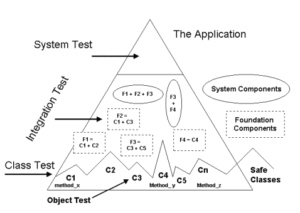
Firmware testing and validation are crucial aspects of firmware design in embedded systems. By thoroughly testing and validating the firmware, engineers can ensure its reliability, functionality, and adherence to requirements. Here are some important facts about firmware testing and validation:
- Unit Testing and Test-Driven Development (TDD):
- Unit testing involves testing individual units or modules of the firmware in isolation.
- Test-driven development (TDD) is a methodology where tests are written before the actual implementation.
- TDD ensures that the firmware meets the defined requirements and allows for iterative development.
- Integration Testing and System-Level Testing:
- Integration testing verifies the proper integration of different firmware components or modules.
- It ensures that the interactions between these components function correctly.
- System-level testing involves testing the complete embedded system, including both hardware and firmware.
- It validates the behavior, performance, and overall functionality of the system.
- Hardware-in-the-Loop (HIL) and Simulation Techniques:
- Hardware-in-the-Loop testing connects the firmware to a simulated or real hardware system.
- It validates the firmware’s behavior in a realistic environment.
- Simulation techniques, such as software-based simulations or virtual prototypes, are used to test firmware functionality without physical hardware.
- These techniques help identify potential issues and optimize the firmware design before implementation.
- Firmware Debugging Tools and Techniques:
- Debugging is a critical part of firmware testing and validation.
- In-circuit emulators, debuggers, and trace analyzers are commonly used tools for firmware debugging.
- These tools help identify and resolve runtime errors, crashes, and unexpected behavior.
- By effectively debugging the firmware, engineers can ensure its stability and correct operation.
- Firmware Validation and Verification Strategies:
- Firmware validation confirms that the firmware meets the specified requirements and performs the intended functions.
- Verification ensures that the firmware design adheres to defined standards and guidelines.
- Code reviews, static analysis, and formal methods are employed for effective validation and verification.
- These strategies help identify design flaws, compliance issues, and ensure the firmware’s reliability and quality.
In summary, firmware testing and validation are integral to the embedded system design process. Unit testing and TDD ensure individual module correctness, while integration and system-level testing verify the firmware’s overall behavior. HIL and simulation techniques enable realistic testing, even without physical hardware. Firmware debugging tools aid in resolving issues and ensuring stability. Finally, firmware validation and verification strategies guarantee compliance and quality. By incorporating these practices, engineers can develop robust and reliable firmware for embedded systems.
Firmware Documentation and Maintenance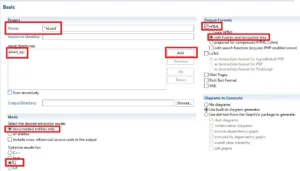
Effective documentation and maintenance are crucial aspects of firmware design in embedded systems. Proper documentation ensures clear understanding, facilitates future updates, and simplifies maintenance processes. Here are some important facts about firmware documentation and maintenance:
- Documentation Standards and Best Practices:
- Documentation standards provide a framework for consistent and structured documentation.
- Following industry best practices ensures that the firmware documentation is comprehensive, accurate, and easily understandable.
- Standardized documentation enhances collaboration among team members and improves overall project efficiency.
- Code Documentation and Commenting:
- Code documentation involves describing the purpose, functionality, and usage of different firmware components or functions.
- Commenting within the code helps other developers understand the code logic and implementation details.
- Clear and concise comments can significantly aid in the maintenance and debugging process.
- Firmware Versioning and Documentation Management:
- Firmware versioning involves assigning unique identifiers to different versions of the firmware.
- Versioning enables tracking and managing changes, bug fixes, and new feature additions.
- Maintaining detailed documentation for each firmware version helps understand the evolution of the firmware and its associated changes.
- Firmware Maintenance and Bug Fixing:
- Firmware maintenance involves ongoing efforts to support and enhance the firmware’s functionality throughout its lifecycle.
- Regular bug fixing addresses reported issues and ensures the firmware remains stable and reliable.
- Maintaining an organized bug tracking system streamlines the process of identifying, prioritizing, and resolving firmware issues.
- Legacy Firmware and Firmware Refactoring Techniques:
- Legacy firmware refers to older versions of firmware that are still in use.
- Firmware refactoring techniques involve restructuring and improving the existing firmware codebase without changing its external behavior.
- Refactoring can enhance readability, maintainability, and performance, making legacy firmware easier to maintain and update.
In conclusion, firmware documentation and maintenance are critical aspects of embedded system design. Following documentation standards and best practices, documenting code and using comments, and implementing firmware versioning ensure clarity and facilitate future updates. Effective firmware maintenance, including bug fixing and an organized bug tracking system, ensures the stability and reliability of the firmware. Lastly, dealing with legacy firmware through refactoring techniques improves its maintainability and updateability. By prioritizing documentation and maintenance, engineers can create robust and sustainable firmware for embedded systems.
References
Embedded Systems Firmware Demystified
Automotive Embedded Systems Handbook
Embedded Firmware Solutions: Development Best Practices for the Internet of Things
Developing Reusable Firmware: A Practical Approach to APIs, HALs and Drivers
Hardware/Firmware Interface Design: Best Practices for Improving Embedded Systems Development
